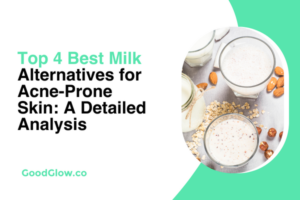Dairy milk (and other dairy products) should be avoided if you are trying to clear acne-prone skin.
Dairy is one of the worst foods you can consume when trying to clear acne, according to a study conducted by Dr. Christian Juhl at the University of Copenhagen.
Not only does dairy aggravate existing acne, but it also worsens skin inflammation and increases sebum production.
Dairy also triggers digestive issues for anyone with lactose intolerance.
However, this does not mean you need to cut out “milk” completely.
Because of these dairy consequences, we resort to plant based alternatives and milk from other animals.
The GoodGlow team analyzed a total of 10 alternatives to dairy milk, and found 6 alternatives that are better for acne-prone skin than cow’s milk (assuming you have no allergies). We will take a look at every alternative below starting with the milk alternatives that are better for your skin than cow’s milk and then moving on to milk alternatives that may seem healthy but are actually worse for your skin than normal cow’s milk.
Why You Should Avoid Dairy Milk if You Want Clear Skin
When you consume milk products from these cows, your hormones may be put off balance and affect your overall health.
This is because almost all dairy cows are given artificial hormones that increase their milk production.
In the eBook included in the Clear Skin Resource Kit, I break down several reasons why dairy is linked to acne:
- Dairy contains IGF-1 hormones that clog pores
- Most dairy triggers a significant insulin (an acne-causing hormone) response. This aggravates hormonal acne
- Protein found in dairy (casein) can damage the digestive system in some people
- Dairy is high in calcium, which prevents zinc, a crucial nutrient for clear skin, from being absorbed
- Many people are allergic or intolerant to dairy, which can cause inflammatory acne

While some dairy is better than others on these issues, milk is one of the worst.
- Milk triggers a huge insulin response – insulin contributes to hormonal acne
- Most milk contains high amounts of casein A1 protein, which can damage the gut and cause acne
- It’s extremely high in lactose and whey, which can trigger acne in certain individuals
Overall, milk is one of the worst drinks you could have if you’re trying to get clear skin.
While raw, grass-fed milk from sheep or goats is likely to be tolerated better than pasteurized cow milk, there are better choices.
Luckily, there are some much better options when it comes to dairy-free milk substitutes for acne-prone skin.
The Best Dairy-Free Milk Substitutes for Acne-Prone Skin
The best dairy-free milk substitutes will all have the same thing in common: no added sugar and minimal added ingredients in general.
If you’re buying coconut or almond milk with tons of added ingredients and sugar, it’s not going to matter how organic or high in vitamin E it is. Consuming these processed alternatives will likely trigger a large hormonal release that’ll make your acne worse.
Always go for sugar-free, natural milk alternatives with the least amount of added ingredients possible.
1. Coconut Milk
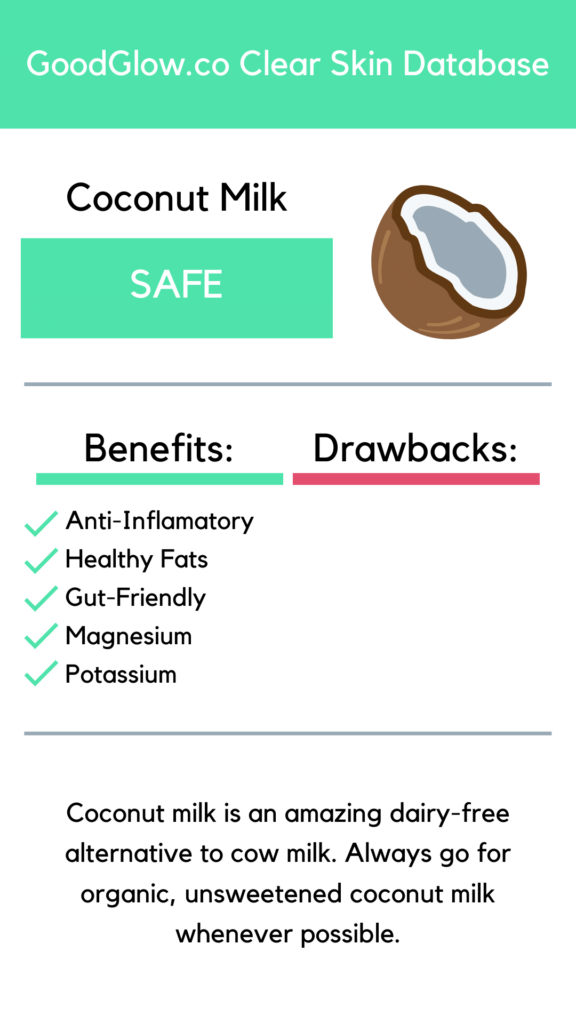
Coconut milk is an amazing substitute for dairy milk as long as it meets a few criteria:
- No added sugar
- Minimal added ingredients
- Organic and cold-pressed, if possible
Coconut milk is low in sugar, low in inflammation-causing omega-6 fatty acids, and high in skin-clearing nutrients, including magnesium (26% DV/cup), potassium (142%), and selenium.
It’s also a great source of high-quality saturated fats, which makes coconut oil a superior cooking ingredient than most cooking oils.
The fat in coconut milk is also a great way to eliminate harmful bacteria and lower inflammation, two additional benefits for acne.
On top of that, most coconut oil is gluten-free, soy-free, and unlikely to cause any issues to your gut or digestive system. Coconuts are among the safest, most digestible plants you could possibly eat.
You can make your own coconut milk or purchase high-quality, unsweetened coconut milk online (I prefer powder) or at most grocery stores.
Bottom line: Coconut milk is a safe choice for acne-prone skin and could help clear existing acne if you substitute it for your daily glass of dairy milk at breakfast.
2. Macadamia Milk

Macadamia milk is a highly safe dairy-free milk alternative that is safe for acne prone skin, assuming you do not have a macadamia nut allergy.
The reason for this is simple: macadamia nuts are an extremely acne-safe, easy-to-digest, and low-carb food that is unlikely to trigger inflammatory or hormonal acne.
Macadamia nuts are rich in healthy monounsaturated fats and very low in inflammation-causing omega-6 fatty acids (unlike many other dairy-free milk substitutes).
There are only two caveats to macadamia milk: sweetened macadamia milk should be avoided, and individuals with allergies or intolerances to tree nuts should opt for something else.
It may be hard to find macadamia milk, but if you can, it’s one of the best options out there.
Bottom line: Macadamia milk is extremely safe for your health and your skin.
3. Almond Milk
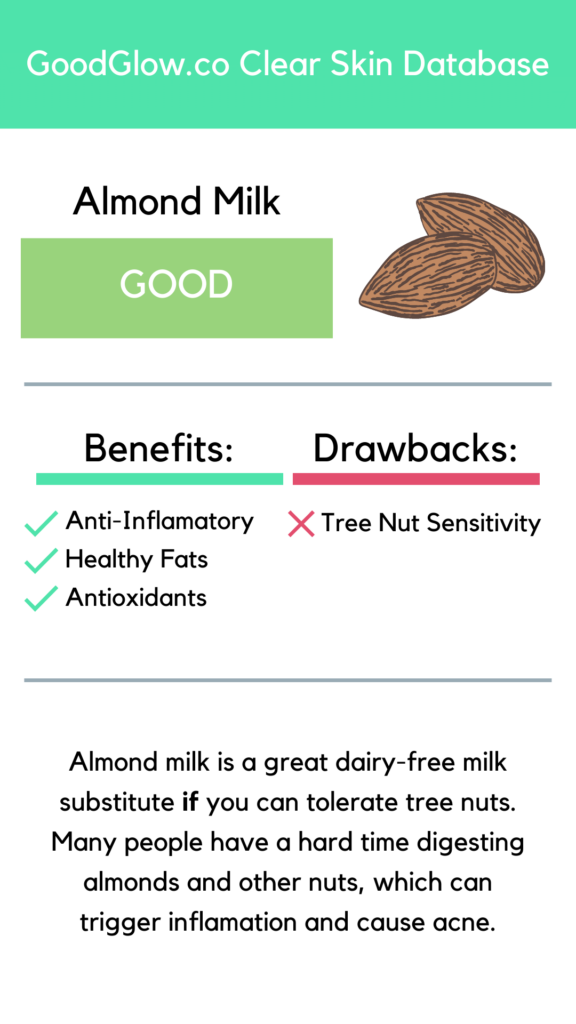
Macadamia milk is a highly safe dairy-free milk alternative that is safe for acne prone skin, assuming you do not have a macadamia nut allergy.
The reason for this is simple: macadamia nuts are an extremely acne-safe, easy-to-digest, and low-carb food that is unlikely to trigger inflammatory or hormonal acne.
Macadamia nuts are rich in healthy monounsaturated fats and very low in inflammation-causing omega-6 fatty acids (unlike many other dairy-free milk substitutes).
There are only two caveats to macadamia milk: sweetened macadamia milk should be avoided, and individuals with allergies or intolerances to tree nuts should opt for something else.
It may be hard to find macadamia milk, but if you can, it’s one of the best options out there.
Bottom line: Macadamia milk is extremely safe for your health and your skin.
4. Goat / Sheep Milk
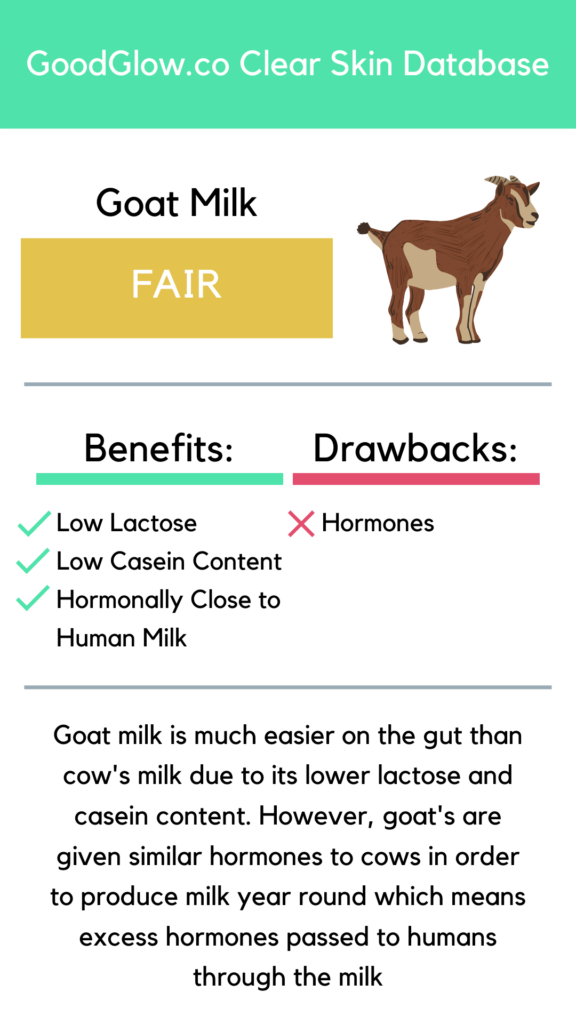
A better choice than milk from cows? Absolutely.
A good choice for your skin overall? Probably not.
Sheep and goat milk are better than cow milk for a few reasons:
- Lower in lactose – it’s less likely to cause an allergic reaction
- Much lower in casein A1 protein – less likely to cause gut/digestive issues
- Hormonally closer to human milk – goat and sheep milk is a better fit when it comes to hormones than cow milk
Still, goat and sheep milk is not safe for acne-prone skin for a few reasons:
- It’s still full of hormones, including IGF-1 and added growth hormones from farmers
- It’s still high in calcium, which can prevent zinc absorption
- It still has some lactose, granted not as much
Overall, you’re much better off going with plant-based, dairy-free alternatives like coconut or almond milk.
5. Cashew Milk
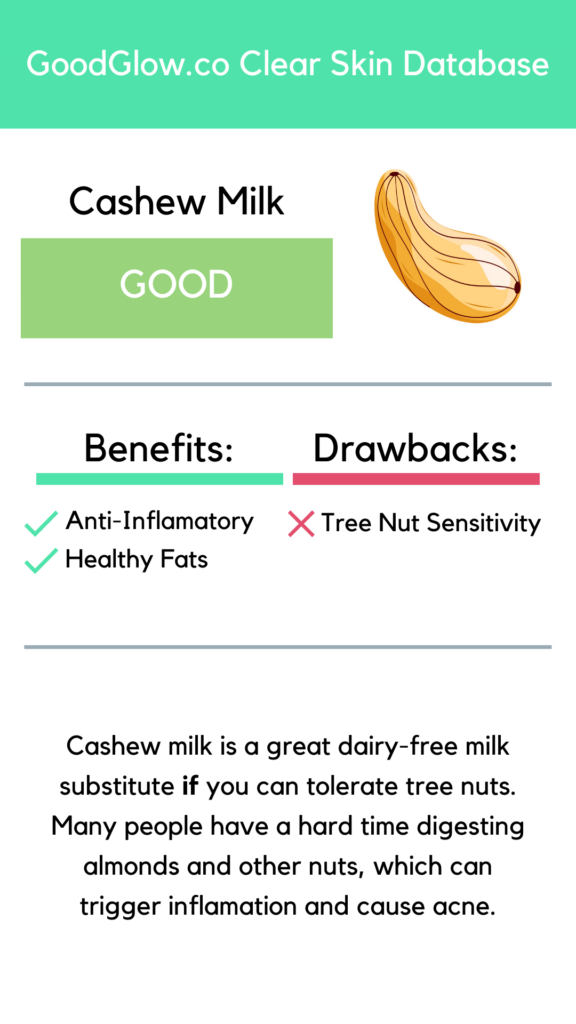
Cashew milk is a superior alternative to dairy milk for acne-prone skin, even though cashew nuts can trigger acne breakouts due to their high levels of carbs and phytic acid,
Some benefits of cashew milk if you have acne prone skin:
- Low in inflammatory omega-6 fatty acids (0.4g/cup)
- Has very little vitamin B12, unlike most other milk substitutes
- It is low in carbs and high in healthy fats
Some negatives to drinking cashew milk if you have acne prone skin:
- High in phytic acid, which can prevent nutrients from being absorbed
- Fairly high in calcium, which can make it harder for your body to absorb zinc
Some people also have a hard time digesting cashews and other nuts (often due to undiagnosed allergies or intolerances)– if this is the case, do not make cashew milk part of your daily diet.
Bottom line: Cashew milk is a pretty solid and safe choice when it comes to dairy-free milk alternatives for clear skin.
6. Oat Milk
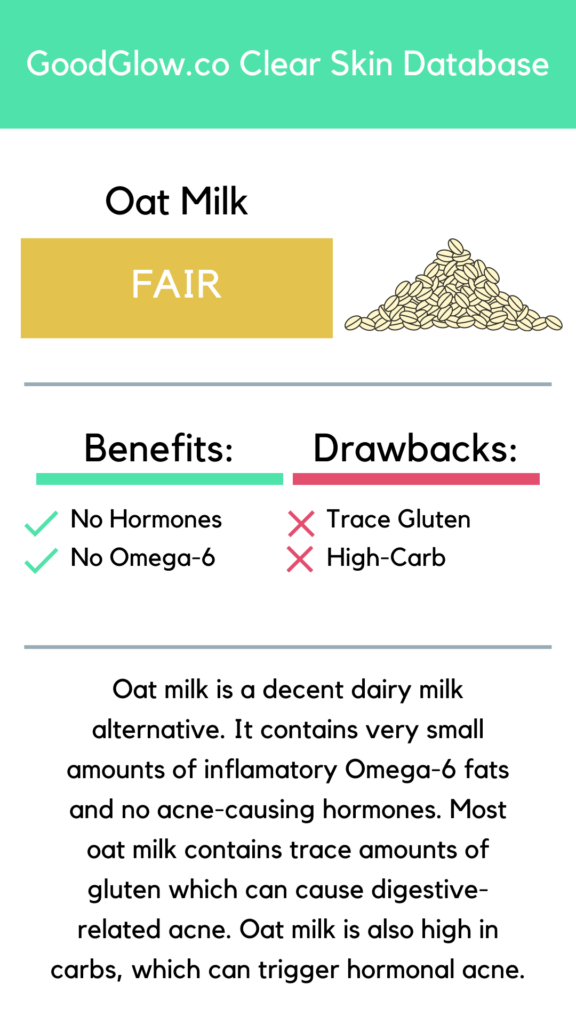
Oat milk isn’t the worst choice when it comes to dairy-free milk alternatives. In fact, some people might tolerate it just fine.
Some people would use oat milk for their skincare routines too.
Still, there are a few downsides:
- Most oat milk contains trace amounts of gluten from processing. If you’re sensitive to gluten, this can be an issue.
- It’s pretty high in carbs (20g/cup) without a whole lot of fiber – this can lead to insulin spikes and hormonal acne.
These aren’t enough to make oat milk public enemy number one, in fact, it’s probably a better choice for most people than cow’s milk. Still, when there are alternatives like coconut milk or almond milk available, it’s a no-brainer to go with these safer options.
Bottom line: Oat milk isn’t a horrible choice for acne-prone individuals unless you are sensitive to gluten or carbs.
Dairy Milk Alternatives That Make Acne Worse
Below we have a list of several dairy milk alternatives that are actually much worse for acne-prone skin than traditional acne. If you are looking for a suitable substitute for dairy milk stick to the alternatives listed above and just make a note to avoid everything the four plant based alternatives we have listed below.
1. Hemp Milk
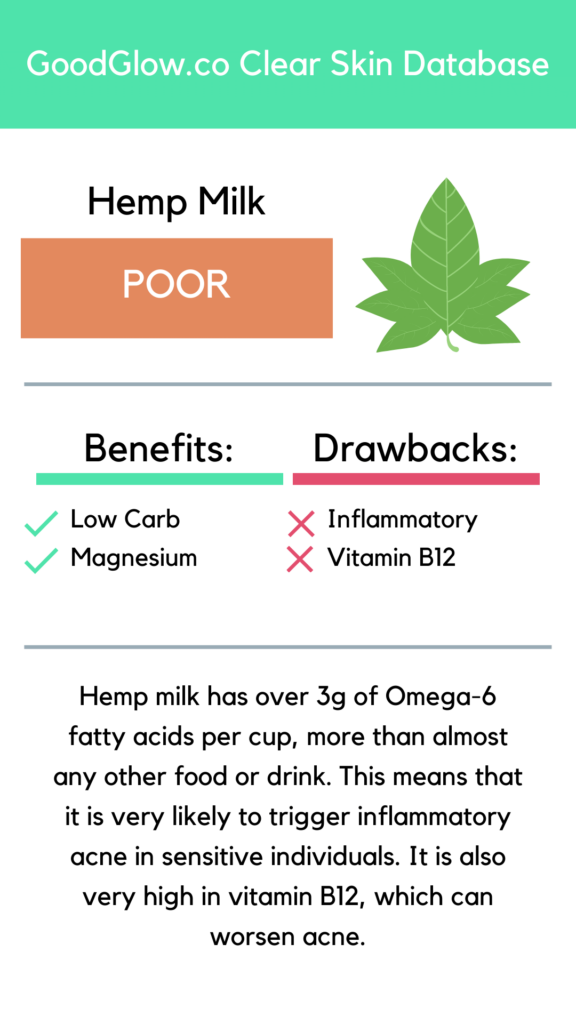
Hemp milk should be avoided for acne sufferers due to its high omega-6 fatty acid and B12 content.
On the surface, hemp milk is a decent alternative to dairy milk for acne-prone skin. It’s low in carbs and high in nutrients like magnesium.
Unfortunately, hemp milk is extremely high in inflammation-causing omega-6 fatty acids which actually make it worse than cow milk when you are trying to clear acne prone skin.
A single cup of hemp milk has over 3.0g of omega-6 fatty acids.
Consuming too many omega-6s without enough omega-3s (found in fish) can lead to chronic inflammation – a condition where the immune system fires off an inflammatory response for minor threats, which can result in acne.
This takes a relatively mild acne infection and transform it into a bright, red, protruding pimple.
Even though hemp milk is high in omega-3 fatty acids, which help fight inflammation, they’re high in the wrong type of omega-3s, ALA.
Your body is very inefficient at breaking down ALA omega-3s into usable omega-3s, which is part of why plant-based and Vegan diets can lead to acne.
Additionally, hemp milk is high in vitamin B12, which can make acne worse.
Bottom line: Hemp milk is not a great alternative for acne-prone skin due to its high levels of inflammatory omega-6 fatty acids even though its taste and texture make it the most similar plant based milk to cow’s milk.
2. Rice Milk

Rice milk is typically the highest in carbohydrates among dairy-milk alternatives, making it a prime candidate to spike insulin levels and trigger hormonal acne.
Although rice itself contains problematic anti-nutrients that can trigger acne – specifically lectins and phytic acid, these compounds are typically contained in the “hull” which is removed before the rice is converted into rice milk.
However, brown rice still contains trace amounts of these compounds, making it more likely to trigger inflammation and acne. This can be problematic because the type of rice milk you buy has a varying effect on your skin.
Although most rice milk is relatively low in omega-6 fatty acids is relatively easy to digest, it is still likely to worsen acne if you introduce it to your daily diet.
Overall, neither white rice milk nor brown rice milk is a great alternative to dairy consumption.
Bottom line: White rice milk is relatively easy to digest but high in carbs. Brown rice milk is more difficult to digest and more likely to lead to inflammatory acne.
3. Flaxseed Milk
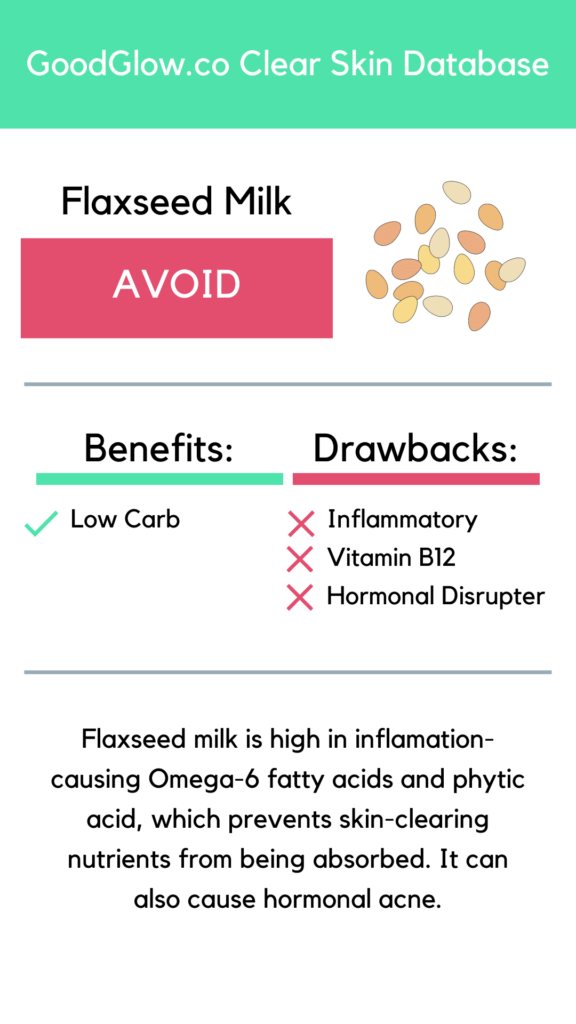
On the surface, flaxseed milk looks like a good alternative to dairy milk because it’s low in carbs and high in anti-inflammatory omega-3 fatty acids.
Below the surface, flaxseeds and flax milk all have a plethora of problems for acne:
- High in inflammation-causing omega-6 fatty acids (1.7g/tablespoon of seeds)
- High in phytates, an antinutrient that prevents skin-clearing vitamins and minerals from being absorbed
- Can potentially throw off the hormonal balance of estrogen and testosterone, leading to hormonal acne
Finally, the form of healthy, anti-inflammatory omega-3 fatty acids found in flax milk, ALA, is not the body’s preferred form.
ALA is extremely inefficient in breaking down into usable DHA and EPA omega-3s (which is why you should take a high-quality fish oil supplement).
Bottom line: Flaxseed milk is another plant-based milk alternative that can lead to nutritional deficiencies and hormonal and inflammatory acne
4. Soy Milk
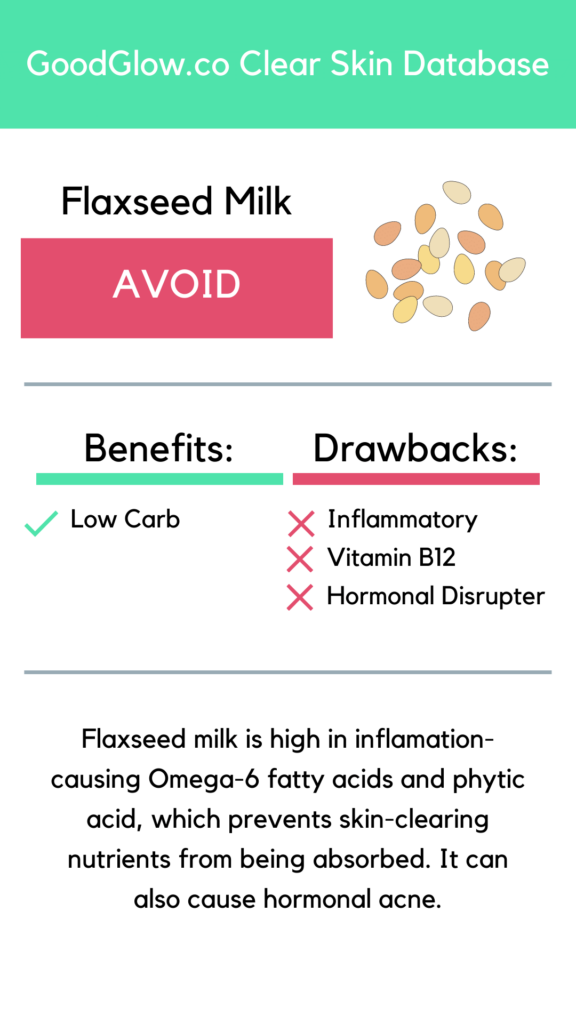
Soy and soy products, including soy sauce, tofu, soy milk, and even plant-based protein powder, are a nightmare for acne.
Soy milk is high in saponin and phytic acid, compounds (antinutrients) that can easily cause damage to the digestive system. These compounds prevent crucial skin-clearing nutrients, like zinc, from being absorbed.
Furthermore, soy milk is high in phytoestrogens, which can disrupt your hormonal balance and lead to hormonal acne. Just like dairy milk, soy milk can lead to hormonal acne.
Even though soy low in carbs and omega-6 fatty acids, soy milk is one of the worst choices for plant-based milk substitutes.
Bottom line: Soy milk is high in antinutrients that damage the digestive system and impair nutrient absorption, and can lead to hormonal imbalances that trigger acne
Are all dairy products bad for acne?
No, not all dairy products will trigger acne breakouts. Specifically, both greek yogurt and cottage cheese are packed with skin friendly nutrients like selenium, and gut repairing probiotics that can help heal and forty the skin barrier. Having said this, cheese, ice cream, and other dairy based creams should be avoided if you really want to see if dairy is the cause of your breakouts. You are unlikely to see any improvement in your acne if you cut out milk with breakfast but still keep ice cream, pizza, and nachos in your diet!
Summary
In this article, we looked at a couple of things…
First, we talked about why you should never drink dairy milk if you have acne-prone skin:
- Dairy is a nightmare for hormonal acne
- Casein (dairy protein) can damage the gut and cause inflammatory acne
- A lot of people are sensitive or intolerant to dairy without even knowing it
Then, we looked at some better alternatives, including
- Coconut milk – low in sugar, easy to digest, nutritious (we like Terrasoul)
- Almond milk – high in antioxidants, a great choice if you can handle tree nuts (we like rude health
- Cashew milk – a very safe option if you can digest tree nuts
Next, we looked at a few alternatives that you’re better off avoiding if you want clear skin:
- Hemp milk – high in inflammatory omega-6 fatty acids
- Flaxseed milk – inflammatory and can throw off hormonal balance
- Oat milk – high in carbs, contains trace amounts of gluten, but not a horrible alternative
- Soy milk – a nightmare for hormonal acne, full of anti-nutrients
Remember, when buying milk alternatives, the most important thing is avoiding added ingredients and sweeteners that cause acne.
If your acne persists and continues to get worse, consult your dermatologist for professional help.
Frequently Asked Questions
A: Oat milk with added sugar will cause an insulin response and can increase both frequency and severity of acne. If you drink oat milk without any added sugar then oat milk is probably a better option for your skin than traditional cow milk.
If you are suffering from acne almond milk is preferable to traditional dairy. Just make sure the almond milk you buy does not have added sugar. Almond milk products with added sugar have been known to cause acne breakouts.
You may want to try out coconut milk, almond milk, and cashew milk as alternatives to cow’s milk.
A: Dairy cows are given artificial hormones, which impact their milk output. Researchers believe that consuming milk products may put your hormones out of balance and worsen acne.
A: If you’re seeking a dairy replacement that can enhance your skin, you can try coconut milk or almond milk instead of oat milk.
A: Eggs are NOT considered a dairy product. While eggs are produced by animals and thus an animal by-product, they are not a derivation of dairy products.
Sources:
Juhl, Christian R., et al. “Dairy Intake and Acne Vulgaris: A Systematic Review and Meta-Analysis of 78,529 Children, Adolescents, and Young Adults.” PubMed Central (PMC), 9 Aug. 2018, www.ncbi.nlm.nih.gov/pmc/articles/PMC6115795
“Can The Right Diet Get Rid of Acne?” Can The Right Diet Get Rid of Acne?, www.aad.org/public/diseases/acne/causes/diet. Accessed 13 Dec. 2022
Szilagyi, Andrew, and Norma Ishayek. “Lactose Intolerance, Dairy Avoidance, and Treatment Options.” PubMed Central (PMC), 15 Dec. 2018, www.ncbi.nlm.nih.gov/pmc/articles/PMC6316316
Sethi, Swati, et al. “Plant-based Milk Alternatives an Emerging Segment of Functional Beverages: A Review.” PubMed Central (PMC), 2 Sept. 2016, www.ncbi.nlm.nih.gov/pmc/articles/PMC5069255
“Bovine Somatotropin (bST).” Bovine Somatotropin (bST) | FDA, 13 Apr. 2022, www.fda.gov/animal-veterinary/product-safety-information/bovine-somatotropin-bst
MALEKINEJAD, Hassan, and Aysa REZABAKHSH. “Hormones in Dairy Foods and Their Impact on Public Health – a Narrative Review Article.” PubMed Central (PMC), www.ncbi.nlm.nih.gov/pmc/articles/PMC4524299. Accessed 13 Dec. 2022
MALEKINEJAD, Hassan, and Aysa REZABAKHSH. “Hormones in Dairy Foods and Their Impact on Public Health – a Narrative Review Article.” PubMed Central (PMC), www.ncbi.nlm.nih.gov/pmc/articles/PMC4524299. Accessed 13 Dec. 2022
Kim, Hyojin, et al. “Insulin-Like Growth Factor-1 Increases the Expression of Inflammatory Biomarkers and Sebum Production in Cultured Sebocytes.” PubMed Central (PMC), 3 Feb. 2017, www.ncbi.nlm.nih.gov/pmc/articles/PMC5318522
PhD, Helen Kollias. “Research Review: Fast Vs. Slow Whey for Protein Synthesis.” Precision Nutrition, 16 Sept. 2011, www.precisionnutrition.com/whey-vs-casein
Wood, Sam. “The Ultimate Guide to Curing Inflammatory Acne – GoodGlow.” https://goodglow.co/zinc-acne-supplement-clear-skin
“Can The Right Diet Get Rid of Acne?” Can The Right Diet Get Rid of Acne?, www.aad.org/public/diseases/acne/causes/diet. Accessed 13 Dec. 2022
“Chemistry and Composition of Coconut Oil and Its Biological Activities.” Chemistry and Composition of Coconut Oil and Its Biological Activities – ScienceDirect, 28 Jan. 2022, www.sciencedirect.com/science/article/pii/B9780128241356000258
Wood, Sam. “Can a Low-Carb Diet Cure Acne? – GoodGlow.” GoodGlow, 11 Nov. 2018, https://goodglow.co/keto-low-carb-acne
Wood, Sam. “Is Coconut Oil Good for Acne? 3 Reasons Why – GoodGlow.” GoodGlow, 28 Oct. 2018, https://goodglow.co/coconut-oil-more-effective-than-over-the-counter-cleansers-at-treating-acne
Wood, Sam. “Does Soy Cause Acne? 4 Ways Soy Can Cause Breakouts – GoodGlow.” GoodGlow, 10 May 2022, https://goodglow.co/does-soy-cause-acne
Tu, Xing‐Hao, et al. “A Comprehensive Study of Raw and Roasted Macadamia Nuts: Lipid Profile, Physicochemical, Nutritional, and Sensory Properties.” PubMed Central (PMC), 27 Jan. 2021, www.ncbi.nlm.nih.gov/pmc/articles/PMC7958573
“Safety of Milk and Dairy Products.” Safety of Milk and Dairy Products – ScienceDirect, 9 Aug. 2019, www.sciencedirect.com/science/article/pii/B9780128163337000059
“Development of a Non-dairy Probiotic Fermented Product Based on Almond Milk and Inulin – PubMed.” PubMed, 1 Sept. 2015, https://pubmed.ncbi.nlm.nih.gov/25028153/
Kang, Dezhi, et al. “Vitamin B12 Modulates the Transcriptome of the Skin Microbiota in Acne Pathogenesis.” PubMed Central (PMC), www.ncbi.nlm.nih.gov/pmc/articles/PMC6049814. Accessed 13 Dec. 2022.
Wood, Sam. “Does Almond Milk Cause Acne? Benefits, Disbenefits, Alternatives.” GoodGlow, 28 Apr. 2021, https://goodglow.co/almond-milk-acne
Wood, Sam. “Do Nuts Cause Acne? 11 Nuts Ranked From Best to Worst for Acne.” GoodGlow, 6 Feb. 2021, https://goodglow.co/the-best-and-worst-nuts-for-acne
Curl, Sarah, et al. “Plant-Based Milks: Hemp.” EDIS, vol. 2020, no. 5, University of Florida George A Smathers Libraries, Oct. 2020. Crossref, https://doi.org/10.32473/edis-fs420-2020
Wood, Sam. “The Best and Worst Seafood for Acne – GoodGlow.” GoodGlow, 11 Mar. 2019, https://goodglow.co/best-worst-seafood-for-acne-salmon-sardines-cod
Wood, Sam. “The Ultimate Guide to Curing Inflammatory Acne – GoodGlow.” GoodGlow, 2 June 2018, https://goodglow.co/chronic-inflammation-acne
“Office of Dietary Supplements – Omega-3 Fatty Acids.” Omega-3 Fatty Acids – Consumer, 18 July 2022, https://ods.od.nih.gov/factsheets/Omega3FattyAcids-Consumer/
Wood, Sam. “Why Your Vegan Diet Might Be Giving You Acne – GoodGlow.” GoodGlow, 14 Jan. 2019, https://goodglow.co/plant-based-diets-acne-vegan-vegetarian-ultimate-guide
Lamothe, Meagan, et al. “Plant-Based Milks: Rice.” EDIS, vol. 2020, no. 5, University of Florida George A Smathers Libraries, Oct. 2020. Crossref, https://doi.org/10.32473/edis-fs412-2020
Gupta, Raj Kishor, et al. “Reduction of Phytic Acid and Enhancement of Bioavailable Micronutrients in Food Grains.” PubMed Central (PMC), 24 Apr. 2013, www.ncbi.nlm.nih.gov/pmc/articles/PMC4325021
Wood, Sam. “5 Reasons Why Zinc Helps Cure Acne – GoodGlow.” GoodGlow, 27 Jan. 2019, https://goodglow.co/zinc-acne-supplement-clear-skin
Desmawati, Desmawati, and Delmi Sulastri. “Phytoestrogens and Their Health Effect.” PubMed Central (PMC), 14 Feb. 2019, www.ncbi.nlm.nih.gov/pmc/articles/PMC6390141
